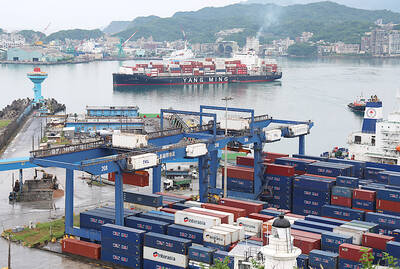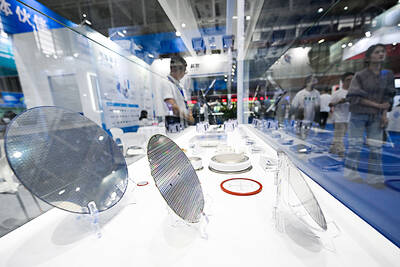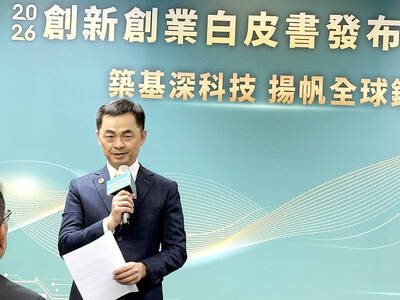China has scrapped safeguard tariffs on five types of steel products imported from Japan, South Korea, Russia, Ukraine, Taiwan, Germany and Kazakhstan, state media said yesterday.
"In light of current developments in the steel market and with the approval of the State Council, the ministry has decided to end safeguard tariffs on steel imports, effective from Dec. 26," the commerce ministry said in a statement.
Following the US
The move follows a decision by the US to rescind steel tariffs earlier this month.
China imposed the tariffs on cold-rolled thin plate steel, hot-rolled thin plate steel, cold-rolled stainless steel, pre-coated galvanized steel and non-grain-oriented silicon steel for three years in November last year.
Like their US counterparts, Chinese household appliance and auto manufacturers have been complaining bitterly about the tariffs since their imposition, and have been lobbying hard for their removal.
More imports
A spokesman for Baoshan Iron and Steel Co (
Baoshan's vice-president and chairman Ai Baojun said earlier this week that, in the face of surging domestic demand, inadequate capacity will be one of the company's key challenges in the new year.
The Baoshan spokesman echoed this view, saying Chinese demand for steel prompted the decision to drop the tariffs.
Analysts said China's tariffs had started looking incongruous after the US admitted defeat, and the EU dropped its own countermeasures.
"China has to consider its role as a member of the WTO in reacting to the US and EU's actions," said Xu Aihua, an analyst with Antaike Information Development Co, a consultancy under the China Iron and Steel Industry Association.
"[It is] similar to its decision follow suit after the US and EU imposed protective measures last year," she said.
Ministry of Commerce figures show China imported 31.05 million tonnes of steel products in the 10 months to October, a 51 percent increase from the same period last year.
Chinese steel exports rose 28.7 percent from a year earlier to 5.71 million tonnes for the same period.

Taiwan’s exports soared 56 percent year-on-year to an all-time high of US$64.05 billion last month, propelled by surging global demand for artificial intelligence (AI), high-performance computing and cloud service infrastructure, the Ministry of Finance said yesterday. Department of Statistics Director-General Beatrice Tsai (蔡美娜) called the figure an unexpected upside surprise, citing a wave of technology orders from overseas customers alongside the usual year-end shopping season for technology products. Growth is likely to remain strong this month, she said, projecting a 40 percent to 45 percent expansion on an annual basis. The outperformance could prompt the Directorate-General of Budget, Accounting and

Two Chinese chipmakers are attracting strong retail investor demand, buoyed by industry peer Moore Threads Technology Co’s (摩爾線程) stellar debut. The retail portion of MetaX Integrated Circuits (Shanghai) Co’s (上海沐曦) upcoming initial public offering (IPO) was 2,986 times oversubscribed on Friday, according to a filing. Meanwhile, Beijing Onmicro Electronics Co (北京昂瑞微), which makes radio frequency chips, was 2,899 times oversubscribed on Friday, its filing showed. The bids coincided with Moore Threads’ trading debut, which surged 425 percent on Friday after raising 8 billion yuan (US$1.13 billion) on bets that the company could emerge as a viable local competitor to Nvidia

BARRIERS: Gudeng’s chairman said it was unlikely that the US could replicate Taiwan’s science parks in Arizona, given its strict immigration policies and cultural differences Gudeng Precision Industrial Co (家登), which supplies wafer pods to the world’s major semiconductor firms, yesterday said it is in no rush to set up production in the US due to high costs. The company supplies its customers through a warehouse in Arizona jointly operated by TSS Holdings Ltd (德鑫控股), a joint holding of Gudeng and 17 Taiwanese firms in the semiconductor supply chain, including specialty plastic compounds producer Nytex Composites Co (耐特) and automated material handling system supplier Symtek Automation Asia Co (迅得). While the company has long been exploring the feasibility of setting up production in the US to address

OPTION: Uber said it could provide higher pay for batch trips, if incentives for batching is not removed entirely, as the latter would force it to pass on the costs to consumers Uber Technologies Inc yesterday warned that proposed restrictions on batching orders and minimum wages could prompt a NT$20 delivery fee increase in Taiwan, as lower efficiency would drive up costs. Uber CEO Dara Khosrowshahi made the remarks yesterday during his visit to Taiwan. He is on a multileg trip to the region, which includes stops in South Korea and Japan. His visit coincided the release last month of the Ministry of Labor’s draft bill on the delivery sector, which aims to safeguard delivery workers’ rights and improve their welfare. The ministry set the minimum pay for local food delivery drivers at